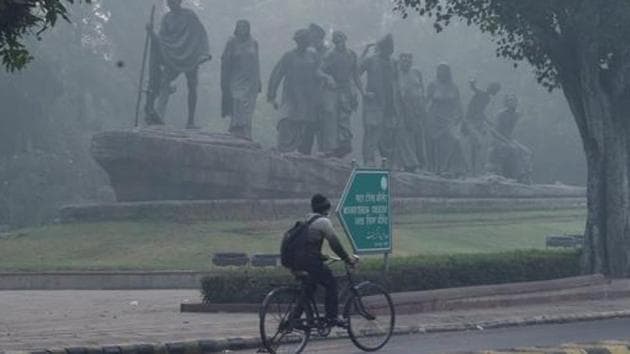Air quality slips in Delhi, another round of bad air in coming week likely
According to weather scientists and experts, Delhi may be in for another spell of bad air in the coming week with local pollutants and unfavourable meteorological conditions largely behind the spike in pollution levels.
The air quality in 21 of Delhi’s 35 monitoring stations on Monday dipped to the ‘very poor’ zone while one station entered the ‘severe’ category as the city’s overall pollution level continued to slide further to the far end of the ‘poor’ category.

According to weather scientists and experts, Delhi may be in for another spell of bad air in the coming week with local pollutants and unfavourable meteorological conditions largely behind the spike in pollution levels.
On Monday, the overall average air quality index (AQI) was 295 in the poor zone, a few notches from ‘very poor’ (301). The air quality has started to plunge again after a week of remaining in the lower to middle end of the poor zone and experiencing a day of ‘moderate’ air quality.
After Diwali, rainfall and good winds had helped clear pollutants and improved the air from ‘severe’ to ‘poor’.
An analysis of AQI data shows that within 10 days, Delhi is on the verge of ‘very poor’ air again. Previously, this month, Delhi saw ‘very poor’ air on November 13, with an average AQI reading of 339.
Delhi’s AQI fluctuated between ‘very poor’ to ‘severe’ and ‘moderate’ in a matter of five days between November 13 and 17.
From an AQI of 435 on November 15, which is in the severe zone, the air quality improved to poor (221) on November 16 and moderate (171) last Tuesday.
Delhi saw its longest spell of ‘severe’ air quality this season with the average AQI remaining in the upper reaches of the category for six consecutive days during November 5-10. Before this, in 2016, the capital breathed severe air quality for six straight days.
Central Pollution Control Board (CPCB) data showed that on Monday, the air in the Jahangirpuri monitoring station was in the ‘severe’ zone (404). Alipur, Anand Vihar, Bawana, Ashok Vihar, Narela, Dwarka sector-8, Mathura Road, Chandni Chowk, DTU, Karni Singh Shooting Range, ITO, Mundka, Nehru Nagar, Okhla, Patparganj, Vivek Vihar, Wazirpur, R K Puram, Rohini, Sonia Vihar, and Punjabi Bagh showed AQI readings in the upper end of the ‘very poor’zone. These include the 13 pollution hots pots across the city.
Government agencies have forecast deterioration in air quality from November 24. V K Soni of the environment monitoring research centre at the India Meteorological Department (IMD) said with wind speed reducing and a dip in temperature, air quality is likely to deteriorate.
“While stubble fires have almost reduced to negligible, change in weather conditions and local emissions are affecting air quality . With a western disturbance affecting the Western Himalayan region, winds will become calmer and may result in a plunge in air quality,” said Soni.
The average wind speed on Monday reduced to 5-6kmph from 15-16 kmph over the past few days. “Air quality may improve slightly only around November 27-28 when wind speed is likely to pick up again after the passing of the western disturbance,” said Kuldeep Srivastava, IMD’s head of regional weather forecasting centre.
Vivek Chattopadhyay, senior programme manager, Centre for Science and Environment (CSE) said Delhi is likely to have another spell of bad air in the coming week. “Our daily analysis has shown particulate matter concentrations are again rising gradually, as good weather conditions have almost retreated. Action on hot spots is still lacking as unpaved roads and local waste burning has been observed in many areas. Vehicular emissions are the same as public transport is still not running to full capacity. Te government needs to tackle all sources of pollution equally, as these come into play when the peak stubble burning season is over,” he said.
According to Delhi Pollution Control Committee (DPCC) officials, measures are in effect, including sprinkling water at key stretches, mechanised sweeping of roads and patrolling of hot spots. “We are monitoring the air quality on a regular basis. Teams are on ground to check local pollution sources such as waste burning and industrial fumes,” said a senior DPCC official, who did not wish to be named.




